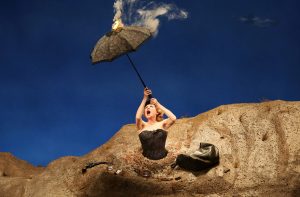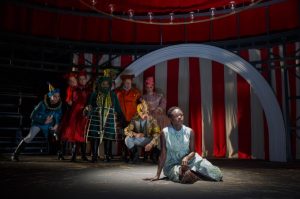Now that Cheeto Voldemort has used his office to thumb America’s nose at the earth, I’m thinking about how art responds to catastrophe. In particular, I’m thinking about the combination of rage and impotence that defines my current experience of environmental politics.
(I know the answer to helplessness is activism. I know that environmentalism does not only work on the national level, especially in the US. I even know that the Paris Agreement is a tepid brew of weak tea, with its purely voluntary targets and non-existent enforcement mechanisms. It’s always been true, as Elizabeth Kolbert reminded us yesterday in the New Yorker, that “the sad fact is that the U.S. has never been a leader in addressing climate change; this is one of the main reasons that the Paris accord is so weak.” But it’s infuriating to watch the President of my country choose to foul our environment in the service of macho illusions and corporate profits. Narcissists don’t really believe in the future.)
But as it happens I’ve been seeing plays about betrayal and the end of the world recently, so I’ve got some performances to think alongside.
Samuel Beckett’s Happy Days, notorious as the play in which an almost-solo female star is immobilized by being buried in the earth for the full duration of the show — up to her waist in the first act, up to her neck in the second — constructs an almost-too-obvious visual symbol for the limits of human power to change our world. Winnie, played with comic genius by Dianne Wiest at Theater for a New Audience in Brooklyn, crooned against her imprisonment. Like Jesse Green in the Times, I thought Wiest was pretty fantastic, “heartbreaking” (in Green’s word) and also poignantly direct in her willingness to approach the script’s paradoxes head on. “Another happy day!” she said, and meant it. What does her optimism mean? Can we follow it?
Even in the shorter second act, when earth up to her neck confined Winnie and prevented her from seeing even herself, her voice searched for “those unforgettable lines” — which, of course, she can’t quite remember. The play’s hashing of English poetry, especially Shakespeare and Milton, almost does what Winnie says she wants it to do: “That is what I find so wonderful, a part remains, of one’s classics, to help one through the day.” But does it really help? It’s hard to tell, on this dark day for environmentalists, if Beckett’s vision of words against the void cherishes scraps of poetry or recognizes that they can’t rescue Winnie and in fact may only serve to whistle against despair. Winnie reported that one of the few other people mentioned in the play, Mrs Shower (or Cooker), said to her, “What’s the idea of you?” The question lingered. Can Winnie’s performance mean something other than leveraging words to make time pass?
The play ended with Winnie singing a fragment of the duet “I love you so,” from The Merry Widow, possibly to her mostly-silent husband Willie, or maybe just to herself. She’s a hard act to follow. Can Beckett be the muse of climate change?
After Beckett’s abstraction, I saw a reprise of Suzan Lori-Parks’s 1996 play Venus, about the tragic life of Saartje “Sarah” Baartman, an African woman exhibited in England and France under the name “Hottentot Venus” in the early 19th century. The production began with the actor Zainab Jah putting on a full-body padded suit to simulate Baartman’s famous figure. In a painful sense, that body suit defined the play: the audience stared at her exaggerated curves, the other cast members stared, her successive captors, from the (Dutch?) man who brought her from Africa to her madam “mother” to the French anatomist who seduced and later dissected her, all stared. The historical Baartman became in the late 20th century a symbol for anti-racist, anti-colonialist, and feminist activism; her remains, which had been on display in Paris until 1974, were returned to South Africa and buried in 2002. In the performance, however, all anyone did was stare, and sometimes touch.
More even than our interpolated gaze, the full force of this show announced itself through the way the small cast (including the always-excellent Tony Torn) assembled and re-assembled their bodies to build human cages around the star. The play itself, in assuming the name Venus and repeating the phrase “Hottentot Venus” throughout, performed the racist history under which Baartman suffered. There was no escaping it. Even during intermission the show went on, as the French doctor performed excerpts from his dissection notes to the half-empty theater. The ten other members of the cast repeatedly surrounded Jah’s Baartman, as fellow member of a carnival show, as an English jury, and as French scientists who wanted to be sure that they could compare the physical measurements they took of her body against those of her skeleton after her death.
The unrelentingness of the play’s representation of injustice was probably starkest in John Ellison Conlee’s second act portrayal of a French anatomist the Baron Docteur, partly based on Frederic Cuvier, who claimed to love Baartman and plied her with chocolates while all the while planning to dissect her corpse. Perhaps the most powerful speech in the play was Baartman’s almost-closing hymn to chocolate and its pleasures. In one of the few moments in which she was nearly alone on stage, and her only extended monologue, she detailed the imperialist history of the arrival of chocolate to Europe from the Americas and its role in the Baron Docteur’s manipulation of her.
The play constructed a painful balance between condemning and representing Baartman’s exploitation. The repeated announcement by the chorus that these events took place after England’s 1807 outlawing of the slave trade drive home their hypocrisy, and ours.
What do these stark plays have to offer an environmentalist reeling after June 1, 2017? Nothing simple. But to the extent that I believe in narrative as a counter to cruelty, and in the partial ability of humans to recognize and redress injustice, perhaps these were good plays for in dark times. What else are plays for?


Leave a Reply